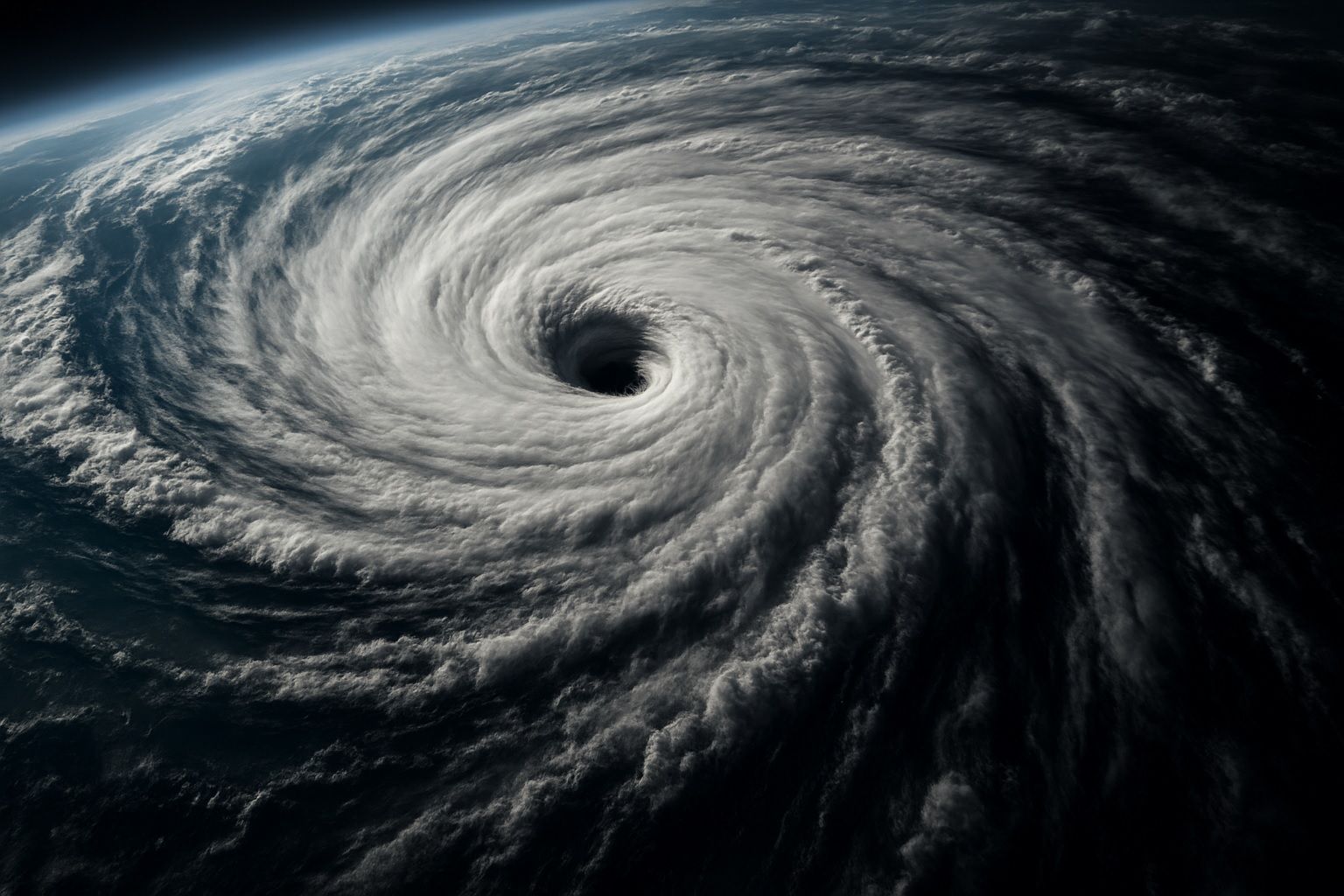- Sentinel-1 radar imaged the aftermath of Cyclone Idai in Mozambique in 2019 and revealed approximately 2,165 km² of flooding around the coastal city of Beira.
- Idai’s satellite flood maps pinpointed about 400,000 people stranded and helped allocate rescue resources.
- NOAA’s GOES weather satellites monitored Hurricane Dorian in 2019 as it approached the Bahamas, providing real-time imagery for track and intensity forecasts.
- The 2010 Eyjafjallajökull eruption led to satellites tracking its ash plume across Europe, prompting unprecedented airspace closures.
- In July 2019, NASA’s FIRMS distributed over 780,000 near real-time fire alerts worldwide.
- The NASA–ISRO NISAR mission, launching in 2024, will scan nearly the entire globe every 12 days with dual-band radar to detect millimeter-scale ground movements.
- During the Australian bushfires of 2019–2020, satellites mapped more than 18.6 million hectares burned and tracked smoke traveling 11,000 km to South America.
- The International Charter on Space and Major Disasters has been activated more than 800 times since 2000, averaging about 50 activations per year.
- Copernicus Emergency Management Service began in 2012 and reached its 800th activation by May 2025.
- The LHASA landslide nowcasting system updates its global nowcast map every 3 hours using satellite rainfall, soil moisture, terrain, and vegetation data.
Earth Observation (EO) refers to the collection of information about Earth’s land, oceans, and atmosphere via remote sensing technologies – primarily satellites, but also drones, aircraft, and ground sensors. In the context of disaster management, EO provides a “big picture” perspective of events as they unfold. This real-time, wide-area view is transforming how we prepare for and respond to natural disasters. By utilizing satellite imagery and other remote sensing data, emergency teams gain unprecedented access to real-time information, enabling faster and more informed decisions on the ground [1]. Such technology sharpens damage assessments and even helps identify vulnerable communities with precision [2]. In a world where climate change is amplifying hazards, EO data has become an indispensable tool to anticipate risks, guide evacuations, target relief, and monitor recovery. A common challenge in past disasters has been delayed or insufficient situational awareness, but EO is closing that gap by delivering timely, actionable intelligence from above [3]. Ultimately, these “eyes in the sky” are helping to save lives and reduce the devastating impacts of floods, fires, storms, earthquakes, and other crises.
Earth Observation in Different Disaster Scenarios
Earth observation technologies are applied across virtually every type of natural disaster. The following sections explore how EO contributes to managing various hazards – from mapping floodwaters to detecting wildfires – with real-world examples illustrating its impact.
Floods
Floods are among the most frequent and destructive disasters globally, and satellites have become crucial for mapping flood extents in near-real time. Radar satellites are especially valuable: they can “see” through clouds and at night, detecting water on the ground even during stormy conditions. For example, Europe’s Sentinel-1 radar imaged the aftermath of Cyclone Idai in Mozambique (2019) and revealed approximately 2,165 km² of flooding around the coastal city of Beira [4]. This turned the Pungwe River valley into an inland sea, with entire communities appearing underwater on the satellite images [5] [6]. Such information was available within days of landfall, long before ground teams could survey the vast area.
Flood maps derived from EO data are critical for damage assessment and relief planning. They show which towns and farmlands are submerged, which roads are cut off, and where help is needed most. Responders used Idai’s satellite flood maps to pinpoint ~400,000 people stranded and allocate rescue resources accordingly [7] [8]. Radar-based flood mapping is now routine – NASA’s algorithms and the EU’s Copernicus Emergency Management Service (EMS) regularly produce flood delineation maps within hours of an event. These maps are often layered with population and land use data (via Geographic Information Systems) to identify which populated areas or infrastructure are affected [9] [10]. In addition, satellite rainfall monitoring (e.g. from the Global Precipitation Measurement mission) enables early warnings for flood risk. High-resolution optical satellites are used post-flood to spot breaches in levees or damage to bridges when skies clear.
EO’s value for floods is reflected in global disaster response statistics: roughly half of all satellite disaster response activations have been for flooding events [11]. An advantage is that one satellite image can cover thousands of square kilometers, surveying regions that might be inaccessible on the ground due to high water. As floods often coincide with heavy cloud cover, radar imagery becomes the workhorse for observing water spread. In the 2022 Pakistan floods, for instance, radar satellites mapped the evolving shoreline of temporary inland lakes, guiding humanitarian aid to cut-off villages. By providing a rapid, synoptic view of inundation, EO data helps emergency managers target evacuations and relief, ultimately reducing flood fatalities and economic losses.
Wildfires
Wildfires can erupt in remote or vast areas where ground surveillance is limited – here, Earth observation truly shines. Satellites equipped with thermal infrared sensors detect the heat signatures of fires 24/7, often becoming the first alert of a wildfire in a remote region [12]. For example, NASA’s MODIS and VIIRS instruments on polar-orbiting satellites continually scan for “hotspots”; even a small flare-up in the Alaskan wilderness will be flagged in their data [13]. These active fire detections are made available through systems like NASA’s Fire Information for Resource Management System (FIRMS), which distributes near real-time fire alerts worldwide. In one week of July 2019, over 780,000 fire alerts were emailed to subscribers globally, including to officials in countries like Russia, the Democratic Republic of Congo, and Zambia [14] [15]. The message is clear: while wildfires may rage in remote corners, they can’t hide from the ever-watchful eyes of satellites.
Beyond detection, EO supports firefighting in multiple ways. Geostationary weather satellites (e.g. GOES) continually monitor large regions and can track smoke plumes and the growth of fire fronts in near real-time. During the catastrophic Australian bushfires of 2019–2020, satellites not only mapped the extent of burned area (over 18.6 million hectares burned [16]) but also tracked smoke spreading across the Pacific – NASA observed smoke from Australia traveling 11,000 km to South America [17]. Such observations warned of air quality impacts far from the fire zone. Closer to the ground, aircraft and drones complement satellites by providing high-resolution imagery of fire perimeters and hotspots through smoke. In the United States, a coordinated effort between the U.S. Forest Service and NASA/NOAA satellites provides a strategic “big picture” to guide fire suppression efforts [18] [19]. During an intense fire season, when dozens of major blazes may exceed the capacity of mapping aircraft, satellite data fills the gap – estimating burn areas, spotting new fires caused by flying embers, and identifying communities at risk from shifting winds [20].
Case in point: when Montana’s Howe Ridge Fire burned for two months in 2018, satellites helped capture the fire’s evolving perimeter and potential damage when smoke or terrain limitations grounded aircraft [21]. Similarly, in Canada’s extreme 2023 fire season, EO satellites like Sentinel-3 tracked the near-real-time progression of hundreds of fires, data which fed into air quality forecasts and firefighting resource allocation. The humanitarian and ecological stakes are high – wildfires threaten lives, property, and produce smoke that causes respiratory crises for downwind populations. EO data enables faster evacuation warnings and more efficient fire containment by showing which fire lines are most active. It also assists in post-fire damage assessment, mapping burn scars to guide reforestation or erosion control efforts. With climate change increasing wildfire frequency, investments in EO (including planned constellations of fire-monitoring micro-satellites) promise even more timely detection and response in the future [22] [23].
Hurricanes and Severe Storms
Tropical cyclones (known as hurricanes or typhoons) and other severe storms are closely watched by Earth observation satellites from their birth to dissipation. Weather observation satellites in geostationary orbit continuously image storm systems, allowing meteorologists to track a cyclone’s path, growth, and intensity hour by hour. This has revolutionized early warning – communities now often have days to prepare or evacuate before a hurricane strikes, thanks to satellite-monitored forecasts. For instance, NOAA’s GOES satellites monitored Hurricane Dorian (2019) as it approached the Bahamas, providing real-time imagery that helped predict its unprecedented stall and devastation on Grand Bahama Island. Lives are saved in the preparedness phase because satellites feed data into hurricane models, improving track and intensity predictions.
Once a storm hits land, Earth observation becomes vital for response. Satellites can quickly map the scope of flooding, wind damage, and infrastructure outages over large disaster zones, even when roads are impassable. Radar imagery is used to map water inundation from storm surge or heavy rain (similar to flood mapping described earlier), while high-resolution optical images reveal details like collapsed bridges or roofs torn off by wind. A striking example of EO in post-storm damage assessment came after Hurricane Maria (2017) in Puerto Rico. NASA scientists used night-time satellite images – the Black Marble dataset – to compare lights across the island before and after Maria. The island was “basically dark” after the storm, and the analysis revealed that over 40% of prolonged power outages occurred in rural areas, versus 29% in urban areas [24] [25]. This pointed to severely affected communities that might otherwise be overlooked. By mapping where the lights stayed out the longest, EO data highlighted the hardest-hit regions, guiding the deployment of repair crews and humanitarian aid (and underscoring the inequality in disaster impacts) [26] [27].
International frameworks leverage multiple satellites for major storms. When Super Cyclone Amphan struck South Asia in 2020, the International Charter was activated to obtain satellite images from around the world, which were then used to delineate flooded coastlines in Bangladesh and India. On average, weather-related disasters (like cyclones and floods) are the most common triggers for international satellite aid, accounting for about 75% of all disaster satellite activations [28]. These collaborative efforts produce maps that show which towns are cut off by flooding, which roads are washed out, and where evacuation centers or survivors might be concentrated. After a storm, optical imagery from commercial satellites (e.g. Maxar or Airbus) is often provided to identify damaged buildings block-by-block; for example, following Typhoon Rai (2021) in the Philippines, very-high-resolution imagery was compared before-and-after to count destroyed structures on remote islands. This rapid damage mapping greatly assists governments and relief agencies in prioritizing response – literally providing a checklist of communities that need immediate help.
Furthermore, EO data aids in secondary impact monitoring: satellites can track oil spills from damaged coastal facilities, or detect potential landslide zones in mountains soaked by a cyclone’s rain. In the longer term, repeated satellite observations support recovery, such as monitoring how fast vegetation regrows or how reconstruction is progressing in affected areas. In summary, from the first early warning of a menacing storm cloud mass to the final recovery monitoring months later, Earth observation is embedded in every stage of hurricane and severe storm management.
Earthquakes
Earthquakes strike suddenly, without warning – but here too, “eyes in the sky” are making a difference in emergency response and scientific understanding. Within hours of a major quake, satellites can map the ground deformation it caused and help identify the areas of worst damage. A primary tool is Synthetic Aperture Radar (SAR), which can measure land movements of just a few centimeters from space. By comparing radar scans from before and after an earthquake, scientists create interferograms and damage proxy maps that highlight where the ground shifted or where buildings likely collapsed [29] [30]. This technique was employed after the massive 7.8 magnitude earthquake in Türkiye and Syria in February 2023: teams from NASA and the Earth Observatory of Singapore processed Sentinel-1 SAR data to produce a detailed damage proxy map within a day [31]. The map clearly showed areas with significant changes (due to building debris and ground distortion), guiding responders to the hardest-hit neighborhoods [32].
At the same time, optical high-resolution satellite images are tasked over cities to visually confirm damage. In the Türkiye-Syria quake, for example, Pléiades Neo satellite images (30 cm resolution) captured the city of Osmaniye on Feb. 7, 2023 (a day after the quake), revealing several collapsed buildings in the northeast of the city [33]. Such images, courtesy of agencies like ESA, were made available to relief organizations to map building-by-building destruction. Critically, they help answer: Which roads are still passable? Where have buildings pancaked into rubble? The International Charter on Space and Major Disasters was activated for this event, and more than 350 satellite images from 17 space agencies were delivered for relief efforts [34] [35]. Using this trove of imagery, value-added providers generated maps for rescuers – helping them navigate rubble, locate intact vs. destroyed bridges, and target search-and-rescue to the worst affected towns [36] [37]. Turkish authorities and the UN credited these rapid maps with speeding up the response across an immense disaster zone.
Earth observation also contributes to understanding the geophysical effects of quakes. The ground deformation maps (using SAR interferometry) show how much the Earth’s crust moved and along which fault lines, providing insights for engineers and scientists. In the 2023 Türkiye quake, Sentinel-1 data revealed ground displacements of several meters across the fault rupture [38], information that is now used in updating building codes and hazard models. Repeated radar passes in the following weeks also identified areas of subsidence (e.g., coastal sinking that led to flooding) and slopes at risk of aftershock-triggered landslides [39] [40].
Emerging EO technology promises to improve earthquake response further. NASA and India’s upcoming NISAR mission (launching 2024) will scan Earth’s land surfaces every 12 days with dual-band radar, capable of detecting subtle “creep” or strain on faults with precision down to fractions of an inch [41] [42]. While satellites cannot predict quakes, these data can identify which fault segments are locked and building stress – essentially highlighting regions at higher risk of future quakes [43] [44]. And when quakes do occur, NISAR’s high-frequency imagery will enable even faster damage assessments, as well as monitoring of post-quake infrastructure stability (e.g. checking if dams or levees have shifted) [45] [46]. In summary, from immediate damage mapping to longer-term risk assessment, EO has become a cornerstone of earthquake disaster management.
Landslides
Landslides are often a hidden catastrophe – they tend to be localized, rapidly occurring, and can be hard to detect in rugged or remote terrain. Earth observation assists with both landslide response and preparedness. Heavy rains or earthquakes often trigger dozens to hundreds of landslides in a region; mapping all of these on the ground could take weeks, but satellites can do it in hours. For example, when an intense storm struck the Philippines in 2022, NASA’s Disasters Program used high-resolution satellite imagery and machine learning to identify over 200 landslides in the affected area, feeding this information into the USGS landslide inventory for that event [47] [48]. This helped local authorities know which mountain villages were cut off by debris or which roads were blocked, even if those locations were initially inaccessible. Similarly, following the 2015 Nepal earthquake, satellites spotted numerous quake-induced landslides across the Himalayas, information that guided helicopter relief missions to remote valleys.
Besides post-disaster mapping, EO is increasingly used for landslide early warnings. NASA has developed a system called Landslide Hazard Assessment for Situational Awareness (LHASA), which combines satellite rainfall data, soil moisture, terrain, and vegetation cover in a machine learning model to predict where landslides are likely in near real-time [49] [50]. The global LHASA “nowcast” map (updated every 3 hours) highlights hotspots – areas in red are facing very high landslide probability in the next day [51] [52]. Emergency managers can use this to evacuate or monitor high-risk slopes ahead of time, potentially saving lives in vulnerable communities in mountainous regions. For instance, during heavy monsoons in South Asia, this model (powered by satellite data from NASA’s GPM precipitation and SMAP soil moisture missions) can alert authorities in Nepal or India to heightened landslide risk, even if ground instrumentation there is sparse [53] [54].
Satellites also enable long-term monitoring of landslide-prone hillsides. Interferometric SAR (InSAR) can detect gradual ground movements – precursors to slope failures – with millimeter accuracy. In landslide-prone areas of California or Italy, for example, regular InSAR surveys have identified slow creeping motion, prompting preventive action before a catastrophic slide occurs. And when a landslide does happen, optical satellite images can delineate the landslide scar and lake dams (if the slide blocks a river) to assess secondary flood risks. One limitation is that dense cloud or forest cover can obscure smaller landslides from optical satellites; here again, radar sensors help by penetrating vegetation to see ground changes. The synergy of multi-sensor data and AI analysis is steadily improving landslide detection rates. As a result, what once were “stealth” disasters are now observed and understood much better through EO, enabling more proactive disaster risk reduction.
Volcanic Eruptions
Active volcanoes are closely surveilled by EO systems to provide early warnings of eruptions and to track volcanic hazards. Thermal infrared sensors on satellites can detect increasing heat at a volcano’s crater or new lava flows, often serving as the first sign of heightened activity. For instance, in June 2023, satellites observed a thermal anomaly at Mexico’s Popocatépetl volcano indicating lava dome growth, which preceded an explosive eruption (prompting temporary evacuations). Likewise, NASA’s MODIS instrument routinely picks up hotspots from erupting lava in places like the Congo’s Nyiragongo or Hawaii’s Kilauea, even if these volcanoes are far from population centers.
One of the most powerful EO techniques for volcanology is InSAR. By analyzing radar satellite images over time, scientists can detect the subtle inflation of a volcano’s surface as magma accumulates underground. This ground deformation monitoring provides a warning of potential eruptions. A famous success story was the monitoring of Mt. Okmok in Alaska: InSAR showed the caldera uplifting in the months before its 2008 eruption, giving scientists a clue of impending activity. More recently, satellite radar was used to measure ground swelling at Hawaii’s Mauna Loa in 2022; a false-color deformation map created by NASA’s ARIA team showed clear uplift, which helped confirm that magma was on the move prior to Mauna Loa’s eruption (its first in nearly 40 years). The forthcoming NISAR mission will greatly enhance this capability globally, scanning volcanoes in dense vegetation (using L-band radar that penetrates foliage) to detect hidden signs of magma pressure build-up [55] [56]. This could be particularly helpful for volcanoes in tropical jungles or remote areas that currently lack ground sensors [57] [58].
When a volcano erupts, satellites play an essential role in tracking volcanic ash clouds and gas emissions. Volcanic ash can be deadly for aircraft engines, so agencies like NOAA and EUMETSAT rely on satellite imagery to map ash plume extent and height, issuing aviation alerts. A notable example was the 2010 Eyjafjallajökull eruption in Iceland – satellites tracked its ash plume spreading over Europe, information that informed the unprecedented airspace closures (and eventually helped refine models so that air travel could resume safely). Satellites with ultraviolet sensors (like NASA’s OMI and the newer TROPOMI on ESA’s Sentinel-5P) detect sulfur dioxide (SO₂) gas released by eruptions, which is key to estimating eruption strength and potential climate impacts. During the massive Tonga undersea volcano eruption in January 2022, satellites measured record-high SO₂ concentrations and even the rise of the eruption plume to the mesosphere. These data were crucial for understanding the global atmospheric effects and alerting Pacific island nations of possible acid rain.
EO also aids response on the ground after eruptions. High-resolution images show the extent of ashfall on communities, helping target ash clean-up and relief (volcanic ash can cause roof collapses and contaminate water supplies). In the 2021 eruption of La Palma (Canary Islands), the EU’s Sentinel-2 and radar Sentinel-1 mapped the lava flow boundaries in near real-time [59], enabling local authorities to issue evacuation orders for neighborhoods in the lava’s path and later to plan road rebuilds across solidified flows. Satellite monitoring continues through the recovery phase: for instance, observing how quickly vegetation grows back on ash-covered land or detecting any post-eruption land instabilities (like landslides on volcanic slopes). All these examples highlight that from pre-eruption warnings to post-eruption recovery, EO is a game-changer. Volcanologists now often say “the volcano under watch never surprises” – a testament to how continuous satellite surveillance is taming the unpredictability of volcanic disasters.
Key Earth Observation Technologies in Disaster Management
EO’s revolutionary impact on disaster management stems from a suite of advanced technologies. Below are some of the key EO tools and techniques and how they contribute:
- Satellite Remote Sensing (Optical and Radar): Satellites are the backbone of EO. Optical imaging satellites (like Landsat, Sentinel-2, or commercial ones like Maxar’s WorldView) capture high-resolution photographs of Earth, useful for assessing damage to buildings, roads, and forests. Modern satellites can have resolution up to 30 cm, providing a “bird’s-eye view” detailed enough to distinguish individual houses or vehicles [60] [61]. They excel in daylight and good weather. On the other hand, radar satellites (Synthetic Aperture Radar) send microwave pulses to Earth and measure the return signal, producing images of the surface regardless of darkness or cloud cover. This all-weather capability is crucial during disasters when clouds or smoke often obstruct optical sensors [62]. SAR can also penetrate some vegetation and measure ground motion (through interferometry), as discussed in earthquake and landslide sections. Together, optical and radar data provide complementary perspectives – optical imagery is intuitive and detailed for visual damage assessments, while radar reveals changes and water presence invisible to the eye. Dozens of EO satellites orbit Earth today, forming a global constellation that monitors disasters 24/7 [63] [64]. Notably, geostationary satellites (like GOES or Meteosat) continuously watch weather systems (hurricanes, wildfire smoke) from a fixed position, whereas polar-orbiting satellites (like Sentinel-1/-2, Terra/Aqua) sweep over every point on Earth at regular intervals, providing repeated coverage for mapping.
- Unmanned Aerial Vehicles (Drones): Drones have emerged as a flexible EO tool for local disaster response. They can be rapidly deployed to hard-hit areas when it’s too dangerous or inaccessible for ground teams. Equipped with cameras (and sometimes lidar or thermal sensors), drones capture very high-resolution imagery – even centimeter-level – useful for inspecting individual structures, landslide debris, or cracks in dams. Drones were used extensively after the 2015 Nepal earthquake to map collapsed buildings in dense urban areas and to survey mountain villages cut off by landslides. In wildfires, fire agencies use drones with infrared cameras to detect remaining hotspots through smoke or at night, improving firefighter safety. Beyond imaging, drones are increasingly being used to deliver supplies (medicine, food) to communities isolated by disasters [65]. For example, after Cyclone Winston (2016) in Fiji, drones ferried medical kits to remote villages when roads were blocked. Their role in disaster management is growing as technology improves. Drones can fly under cloud ceilings that might hinder satellites and can be tasked on-demand by local responders. In essence, they act as a bridge between ground and space – providing granular detail to complement satellite overviews. As regulations evolve, one can expect swarms of autonomous drones to map damage in real-time and even assist in search-and-rescue (through thermal imaging to find survivors).
- Geographic Information Systems (GIS) and Data Integration: GIS technology is the unsung hero that turns raw EO data into actionable insights. GIS platforms allow different layers of data – satellite images, digital elevation models, infrastructure maps, population data, etc. – to be combined and analyzed spatially. In disaster management, GIS helps answer “Where are the impacts?” and “What is in harm’s way?”. For instance, after a flood, satellite-derived water extent maps are loaded into a GIS along with census data to estimate how many people or which critical facilities (hospitals, power stations) are in the flooded zone. This greatly aids prioritizing emergency response. GIS tools also support predictive modeling, such as delineating which areas would be inundated if a dam upstream fails (combining satellite topography with flood models). They can visualize complex datasets in intuitive ways – heat maps, interactive dashboards, etc., which improve decision-makers’ situational awareness. Importantly, GIS enables information sharing among agencies via web-based maps and common operational pictures. During the response to Typhoon Haiyan (2013) in the Philippines, a GIS portal was set up where all humanitarian groups could see updated satellite maps, report field observations, and avoid duplication of efforts. In summary, GIS is the glue that fuses “what the satellite sees” with “what’s on the ground” – turning petabytes of EO data into targeted intelligence for disaster planners [66].
- Artificial Intelligence and Machine Learning: AI is increasingly being leveraged to process the deluge of Earth observation data and extract meaningful patterns far faster than humans alone could. Machine learning algorithms can be trained to recognize features like collapsed buildings, flooded areas, burned forests, or blocked roads in satellite imagery. This enables automated damage mapping shortly after imagery is acquired, speeding up the delivery of critical information. For example, after a hurricane, AI-based tools can compare pre- and post-event images to instantly flag buildings that have been destroyed – something that would take experts days to do manually over large areas [67]. AI is also used in forecasting and early warning: by analyzing vast historical datasets, algorithms can learn to predict which weather patterns will lead to flash floods or how a wildfire might spread based on fuel and weather conditions. The integration of AI with EO is exemplified by systems like NASA’s landslide nowcasting (where a machine learning model ingests satellite precipitation and terrain data to output landslide probabilities [68] [69]) and by experimental projects that use deep learning to detect emerging hot-spots for pandemic outbreaks via satellite (e.g., analyzing nightlight and mobility changes). Predictive analytics powered by AI could forecast disasters before they strike – for instance, identifying which drought-stressed regions are likely to see severe wildfires in an upcoming season [70] [71]. AI also greatly enhances rapid response: it can optimize the routing of relief supplies by analyzing real-time traffic, damage, and weather data in tandem (something humans would struggle to do quickly with so many variables). The bottom line is that AI algorithms excel at sifting through “big data” – and EO is big data. As these algorithms continue to improve, we can expect faster, more accurate, and even predictive insights from Earth observation, reducing the time from data to decision in crisis situations [72] [73].
International Agencies and Collaboration in EO for Disasters
No single country or satellite can cover all disasters, so international collaboration is fundamental to modern disaster management. Fortunately, the global space community has embraced a spirit of cooperation when crises strike, giving rise to several key programs and agreements:
- International Charter “Space and Major Disasters”: This Charter is a flagship of collaboration, uniting 17 space agencies (including ESA, NASA, NOAA, CNSA, ISRO, ROSCOSMOS, JAXA and others) to provide free satellite imagery for emergency response anywhere in the world [74] [75]. When a major disaster occurs, an authorized user (often the affected country’s civil protection agency or the UN) can activate the Charter. Within hours, the member agencies coordinate to task their satellites and gather imagery over the disaster area [76] [77]. This is essentially a one-stop access to a constellation of over 270 satellites via a 24/7 on-call system [78] [79]. Since its inception in 2000, the Charter has been activated more than 800 times for disasters ranging from hurricanes and floods to earthquakes and oil spills [80]. In recent years it’s averaging about 50 activations per year as climate-related disasters surge [81]. Notably, about half of Charter activations have been for floods and a quarter for severe storms (including those that lead to wildfires or landslides) [82]. The Charter’s value was evident in the 2023 Türkiye earthquake: it delivered 350+ images from multiple agencies, which were then used to create maps for rescuers on the ground [83] [84]. Importantly, these products are provided at no cost to the user nation, embodying the humanitarian principle of space-based support for all. Through mechanisms like the Charter (and its Universal Access program), even countries with no domestic space assets can benefit from the collective “eyes in the sky” when disaster strikes.
- Copernicus Emergency Management Service (EMS): Run by the European Commission with technical support from ESA, Copernicus EMS is a free mapping service that can be activated for emergencies globally. It uses Europe’s Sentinel satellites and many others to produce rapid maps of floods, fires, earthquakes, etc. The EMS has two components: Rapid Mapping for immediate post-disaster maps (delivered within hours to days), and Risk & Recovery Mapping for prevention and reconstruction phases. Since it began in 2012, Copernicus EMS has recorded its 800th activation as of May 2025 [85] – responding to disasters both within Europe and worldwide. For example, EMS Rapid Mapping was activated for the 2020 Beirut explosion, the 2021 Haiti earthquake, and flooding in Africa and Asia. The service provides standardized products like delineation maps (showing extent of an event, e.g., flood footprint) and grading maps (assessing severity of damage) for emergency responders [86] [87]. A major strength of Copernicus EMS is that it shares its maps openly on the web, meaning anyone – local governments, NGOs, even the general public – can access and use them. It also connects with the Charter: Europe often contributes Sentinel imagery via the Charter, and in return Charter activations sometimes leverage Copernicus mapping teams [88]. Together, these efforts reinforce each other and ensure that critical Earth observation data and maps reach the disaster zone quickly.
- Sentinel Asia: In the Asia-Pacific region, Sentinel Asia plays a similar role for regional cooperation. Led by the Japan Aerospace Exploration Agency (JAXA), it is a voluntary initiative of over 100 member organizations (space agencies, disaster management agencies, etc.) dedicated to sharing EO data for disasters in Asia-Pacific [89] [90]. Sentinel Asia focuses on events like floods, typhoons, earthquakes and wildfires in Asia. When a disaster happens, members can request data; JAXA and others then task satellites such as JAXA’s ALOS-2, ISRO’s Resourcesat/Cartosat, Korea’s KOMPSAT, etc., to gather images [91] [92]. Data analysis nodes will generate maps which are posted on Sentinel Asia’s web platform for the affected country [93] [94]. Since its start in 2005, Sentinel Asia has conducted over 300 emergency observation campaigns for disasters across Asia [95]. A distinctive feature is its link to the global Charter: if a disaster in Asia needs more data than regional satellites can provide, Sentinel Asia can escalate the request to the International Charter [96]. This multi-layered approach ensures Asia-Pacific nations have rapid access to both regional and global satellite resources in a crisis. It reflects how important multinational collaboration is, especially for developing countries that rely on the goodwill and data from others’ satellites to aid their people.
- National Space Agency Initiatives: The major space agencies each have dedicated programs to apply EO for disaster management, and they often work in tandem. NASA’s Disasters Program (USA) is a part of its Applied Sciences program, aiming to “promote the use of Earth observations to improve the prediction of, preparation for, response to, and recovery from disasters” [97]. It funds research and deployment of decision-support tools (like the flood mapping, landslide nowcasting, and damage proxy maps mentioned earlier) and maintains coordination teams for when U.S. or global disasters occur. NASA also operates the Disaster Response Coordination System to provide on-demand analysis for active events [98]. An example of NASA’s engagement: after the Haiti 2021 earthquake, NASA provided high-res aerial LiDAR scans to map building damage in Port-au-Prince’s dense urban landscape, complementing satellite imagery. ESA, besides running the Copernicus program, contributes through the Earth Observation for Risk Management activities and by offering its Sentinel satellite data freely worldwide. ESA and its member states also contribute high-resolution imagery (e.g., France’s Pleiades) to the Charter. ISRO (India) has a robust Earth observation satellite fleet (like ResourceSat, CartoSat, RISAT radar) and a dedicated Disaster Management Support programme that provides imagery for natural disasters in India and neighbors. In August 2024, ISRO launched EOS-08, a new EO satellite carrying infrared sensors specifically to bolster real-time hazard monitoring and flood detection via a GNSS-reflectometry payload [99] [100]. India has also taken a leadership role in the Charter (assuming Charter chairmanship in 2025) [101]. JAXA (Japan) contributes not only via Sentinel Asia but also with unique assets like the ALOS series of radar satellites, which have provided critical imagery (e.g., interferograms after earthquakes in Asia or wildfire maps in Siberia). China (CNSA) and Russia (Roscosmos) are Charter members as well, adding their satellites (e.g., China’s Gaofen, Russia’s Resurs) to the pool – notably, Chinese satellites have been providing high-res images for disasters in Asia and Africa under both Charter and bilateral agreements. Other national agencies like the Canadian Space Agency (CSA) with RADARSAT, the German Aerospace Center (DLR) with TerraSAR-X, the UK Space Agency, etc., each pitch in through either Charter, Copernicus, or direct support. This international network means that when a disaster happens, it’s not just one country’s satellites overhead – it’s a fleet of many nations’ eyes in the sky working together.
- United Nations and GEO: The United Nations, through UNOOSA’s UN-SPIDER program (United Nations Platform for Space-based Information for Disaster Management and Emergency Response), facilitates developing countries’ access to EO resources. UN-SPIDER acts as a bridge to mechanisms like the Charter and conducts training so that countries can better use satellite-derived information. At a higher level, the Group on Earth Observations (GEO) – a partnership of over 100 countries and organizations – has a dedicated initiative on Disaster Risk Reduction. GEO is fostering the idea of a Global Earth Observation System of Systems, where data from many satellites and sensors is shared openly to address challenges including disasters. In 2022, the UN announced the “Early Warnings for All” initiative, a plan to ensure every person on Earth is protected by early warning systems by 2027. GEO is collaborating with the UN on this effort, with EO data at its core to improve forecasting of floods, storms, and other hazards in developing countries [102]. This is aligned with the Sendai Framework for Disaster Risk Reduction (2015-2030), which explicitly calls for the use of space-based technologies to achieve its targets. Space agencies have embraced this call – for example, CNES (France) cites aligning its EO disaster efforts with the Sendai Framework goals [103]. The overall trend is toward more open data, open science, and sharing to combat disasters. An illustration: since 2020, the Committee on Earth Observation Satellites (CEOS) has a Recovery Observatory initiative where after very large disasters (like the Pakistan floods 2022 or the Beirut blast 2020), satellite data is continuously provided for long-term recovery monitoring [104] [105]. All these collaborations underscore that disaster management is a global challenge requiring a global response – and space-based Earth observation is a domain where international cooperation is truly saving lives.
Benefits of Using Earth Observation for Disaster Management
Earth observation has introduced many benefits and efficiencies in how we handle disasters. Some of the key advantages include:
- Rapid, Large-Scale Coverage: Satellites can survey an entire disaster region within hours, something impossible for ground teams. Up-to-date imagery is typically available within 24 hours of an event, enabling responders to grasp the situation quickly [106] [107]. This rapid data access helps overcome delays in situational awareness – a common shortfall in traditional disaster response.
- All-Weather, 24/7 Monitoring: EO systems ensure continuous eyes on a crisis. Radar satellites image affected areas regardless of clouds or nightfall, and geostationary satellites provide round-the-clock observation [108] [109]. This 24/7 coverage means critical information (like a burst dam at midnight or wildfire spread under smoke) is not missed due to darkness or bad weather.
- High Resolution and Multispectral Insight: Advanced imaging can zoom in to show fine details (sub-meter resolution), allowing identification of damaged infrastructure, landslide scars, or small hotspot fires. Multispectral and thermal data can reveal otherwise hidden phenomena – for instance, infrared bands detect lingering wildfire hotspots under ash, and radar can map moisture and deformation within the ground. These enhanced imaging capabilities give responders and scientists a deep understanding of disaster impacts [110] [111].
- Informed Decision-Making & Resource Allocation: The combination of EO data with GIS analysis leads to smarter disaster response strategies. By mapping what areas are hit and how badly, officials can prioritize evacuations and aid to where they’re needed most. For example, satellite-based flood and population maps help target rescue operations to stranded communities, and wildfire spread maps help decide where firefighters should concentrate efforts. EO also supports logistics – e.g., identifying which roads or bridges are intact for relief convoys. This informed approach maximizes the impact of limited resources in the critical first hours and days of a disaster [112] [113].
- Early Warning and Risk Reduction: Beyond immediate response, EO data underpins early warning systems for weather hazards, drought, and more. Satellites improve forecasts for cyclones, monitor rainfall to warn of floods, and can even hint at landslide or wildfire risks days in advance (through soil moisture or vegetation stress indicators). With initiatives like the UN’s goal of “Early Warnings for All,” EO is front and center in developing life-saving early warning capabilities for vulnerable nations [114]. In the long term, EO also aids resilience building – for instance, hazard maps derived from satellite data (floodplain maps, seismic deformation maps, etc.) inform better land-use planning and stronger infrastructure, mitigating future disaster impacts.
- Global Solidarity and Data Sharing: EO for disasters has fostered an unprecedented level of international cooperation. Through mechanisms like the Charter and Copernicus EMS, countries routinely share satellite data freely in the name of humanitarian assistance. This means even poorer nations can benefit from cutting-edge satellite imagery when facing a catastrophe. The result is a more equitable and effective global disaster response system. Space-based data has truly become a global public good in times of crisis.
- Safety for Responders: By providing intel on where damage and hazards are, EO keeps responders out of harm’s way. Rescue teams can plan routes using satellite maps to avoid still-flooded areas or unstable buildings. In hazardous environments (radiation, chemical spills, volcanic ash), drones and satellites can perform reconnaissance without risking human life. This improves the safety of disaster response operations.
These benefits ultimately translate to lives saved and losses reduced. As Dr. Paul Bate, Chief Executive of the UK Space Agency, aptly summarized: “Satellites play an important role in the response, with Earth observation data used worldwide to map, monitor and mitigate impacts and, ultimately, to save lives.” [115]. By seeing the invisible and mapping the chaos, EO has become an indispensable ally in humanity’s fight against natural disasters.
Challenges and Limitations
While Earth observation has greatly advanced disaster management, it is not without challenges. Recognizing these limitations is important to further improve EO applications:
- Data Gaps and Quality Issues: Not every affected area will have immediate high-quality coverage. Remote or small-scale events might be missed by satellites with coarse resolution. And even when satellites are tasked, image quality can be hampered by weather (clouds, haze) or lighting [116]. For instance, heavy cloud cover over Mozambique after Cyclone Idai initially obscured optical imaging [117]. Although radar mitigates this, not all regions have ready SAR data at high resolution. Image artifacts or low resolution in some sensors can obscure critical details needed for damage assessment [118] [119]. Overcoming this requires more satellites, higher revisit rates, and on-board enhancements – all areas of ongoing development.
- Latency and Real-Time Analysis: There is often a delay between image capture and actionable information, due to downlink, processing, and analysis time. In fast-moving disasters, even a few hours’ lag can hinder decisions [120] [121]. While systems like NASA’s LANCE and others aim to provide imagery within 3 hours of capture [122], getting from raw data to a user-friendly map still takes effort. Streamlining this pipeline with cloud computing and AI is a work in progress. The goal is to approach real-time monitoring – for example, using geostationary satellite data that updates every 5-15 minutes for wildfires and severe storms. Until then, disaster managers must contend with some latency and ensure backup communication methods (since local internet/power outages can delay the receipt of data even if analysis is quick).
- Interpretation and Expertise:Skilled analysts are needed to interpret EO data correctly. A satellite image doesn’t come with labels; distinguishing a muddy field from a shallow flood, or a intact roof from a collapsed one, can be nuanced. Automated algorithms help but are not foolproof – false positives/negatives can occur (e.g., shadows or smoke being misclassified as water or fire). Misinterpretation can lead to misallocated resources [123] [124]. For example, using an outdated image might lead responders to go to a village that is already evacuated or safe. There is a known skill gap in many emergency management agencies when it comes to using geospatial data. This is being addressed by training (like UN-SPIDER workshops, NASA ARSET courses) and by creating simpler map products that don’t require specialist knowledge to use [125]. Nonetheless, ensuring every local emergency operations center can fully leverage EO information remains a challenge.
- Integration of Multiple Data Sources: Combining data from various satellites and sensors (optical, radar, thermal) and from ground reports or social media can be complex. Different data formats, projections, and update times make integration non-trivial [126] [127]. For example, after a hurricane, one might have aerial photos, satellite SAR flood maps, and crowdsourced reports – fusing these into one coherent picture is challenging technically and organizationally. Advanced platforms and standards (like the Open Geospatial Consortium standards) are helping, but responders often operate under time pressure and may not utilize all available data to its fullest. Inter-agency coordination issues sometimes mean satellite data isn’t shared as widely or promptly as it could be. The solution involves not just technology but also establishing protocols and partnerships beforehand.
- Coverage and Connectivity in the Field: In some cases, the people who need EO information (field commanders, local governments) might lack the internet connectivity or equipment to receive large satellite data files during a disaster. Power outages can hamper access to maps (hence why printed maps or offline GIS data are still important). Initiatives like RANET and emergency telecom teams try to bridge this by providing satellite data via alternative means (radio, portable servers), but it remains a limitation that fancy EO analysis in a capital city might not immediately translate to knowledge on the ground in a remote disaster zone.
- Privacy and Ethical Considerations: While not usually a primary concern during disaster response, the increasing use of high-resolution imagery and surveillance (drones, etc.) can raise privacy issues, especially in populated areas. There’s a balance to be maintained between obtaining useful information and respecting the dignity and privacy of affected people (e.g., not broadcasting images of victims). Generally, disaster EO efforts avoid sensitive imagery release, but as capabilities grow, clear ethical guidelines will be important.
- Reliance on Space Infrastructure: Lastly, there’s the simple fact that EO relies on satellites and high-tech systems which themselves could fail or be overwhelmed. A major solar storm or conflict in space could degrade satellite assets exactly when we need them for a hazard on Earth. Redundancy and resilience in the EO constellation is something to continuously build. Also, some very high-resolution data comes from commercial providers who may have restrictions or costs; ensuring open and affordable access to the necessary data is an ongoing policy challenge.
Despite these challenges, the trajectory is positive. Many of these limitations are being actively addressed through international cooperation, technological innovation (like AI to speed up analysis, or microsatellites to plug coverage gaps), and capacity building. Each disaster provides lessons that lead to improved use of EO the next time. As the technology matures, we can expect the benefit-to-limitations ratio to continue improving, with challenges gradually mitigated by smart solutions.
Future Outlook and Innovations
The coming years promise to further integrate Earth observation into disaster management in exciting ways. EO technology is rapidly advancing, and these innovations will make disaster response even more effective and proactive:
- Next-Generation Satellites and Sensors: We are on the cusp of a new wave of satellites with unprecedented capabilities. For example, the NASA-ISRO Synthetic Aperture Radar (NISAR) mission launching in 2024 will significantly boost our ability to monitor Earth’s changes. NISAR will scan nearly the entire globe every 12 days with dual-band radar, detecting movements of the Earth’s surface as small as a few millimeters [128] [129]. This means potential early warnings for earthquakes (by seeing which fault segments are building strain) and for volcanic eruptions (by spotting ground inflation) will be much improved [130] [131]. Similarly, new satellites with higher resolution and higher revisit rates are being launched by various countries and private companies. Constellations of small satellites (CubeSats) are planned to provide hourly imaging of every point on Earth in the next decade, which could enable near real-time monitoring of fast disasters like flash floods or urban fires. We’ll also see more hyperspectral sensors that can identify materials and chemicals – useful for detecting oil spills, gas leaks, or even classifying building damage by the materials exposed. These technical upgrades mean that by 2030, the data available to emergency managers will be even richer: more frequent, more detailed, and covering types of information (like soil moisture, vegetation health, atmospheric gases) that currently might require separate ground instruments.
- AI and Edge Computing for Real-Time Insights: The future of EO is not just more data, but making sense of data faster. Artificial intelligence will be deeply embedded both on satellites and in analysis pipelines on Earth. We expect to see “smart satellites” with onboard AI that can analyze imagery in-space and send down alerts immediately rather than huge raw data files. Experiments are already underway: for instance, an ESA AI algorithm is being tested to detect volcanic eruptions on satellite and trigger an automatic alert within minutes [132]. This could apply to wildfires as well – imagine a satellite that spots a fire and instantly sends coordinates to firefighters’ smartphones, all before the first 911 call. On the ground, AI will play an even bigger role in synthesizing multi-source data and forecasting scenarios. Predictive analytics might forecast, for example, not just that a river will flood, but which specific neighborhoods will have the most damage (by combining elevation models, land use, and river levels). AI-driven decision support systems will advise commanders during a disaster, essentially acting as a disaster “Waze” or “Google Assistant” by processing live feeds of satellite, weather, and social data. The goal is a future where disaster response is proactive and data-driven, with AI flagging risks and suggesting actions before humans even realize the need [133] [134]. However, human oversight will remain crucial to validate AI outputs and ensure ethical use.
- Integration of Drones, Balloons, and IoT: The sky of the future emergency zone will be more crowded – in a good way. Drone technology will continue to advance, with longer flight times, swarming capabilities, and AI-driven autonomy. We may see drone fleets automatically mapping a city after an earthquake, each covering a sector and uploading data to the cloud in real time. High-altitude pseudo-satellites (HAPS) like solar-powered drones or balloons could hover over a disaster area for days, providing continuous high-res surveillance and communications relay. These could be rapidly deployed to supplement space assets, especially when local infrastructure is down. Meanwhile, the Internet of Things (IoT) – billions of ground-based sensors – will feed into the EO ecosystem. Imagine smart buildings with sensors that report structural health after shaking, or an array of inexpensive rain gauges and river monitors sending data to augment what satellites see from above. The fusion of space-based and ground-based sensor networks will paint a fuller picture of disasters, improving both the accuracy of warnings and the effectiveness of response.
- Global Early Warning Systems and Policy Support: On the institutional side, we are likely to see EO fully embedded in disaster governance. The UN’s push for “Early Warnings for All” by 2027 will leverage EO for everything from cyclone tracking to drought monitoring [135]. More countries will establish EO-based emergency operation centers, as some have already done. We can also expect open data policies to expand; the trend is toward making all publicly funded EO data freely accessible in near real-time for disaster purposes. This democratizes information, enabling local startups or universities to contribute solutions (e.g., local flood mapping apps using Sentinel data). Additionally, as climate change drives more extreme events, EO data will inform climate adaptation policies – for example, satellite risk maps might dictate where building codes need strengthening or which areas should avoid new development. In essence, EO will not only react to disasters but help societies plan for them, making communities smarter and more resilient in the face of nature’s threats.
- Humanitarian Impact and Equity: A future focus will also be on ensuring EO benefits all, including the most vulnerable. Initiatives like GEO’s Climate Risk and Early Warning Systems (CREWS) seek to ensure African, Pacific, and Asian least-developed countries get the same quality of satellite information as developed nations. With cheaper technology and open-source tools, local analysts in any country should be able to tap EO data for their community’s needs. We may see more citizen science integration, where residents contribute on-the-ground photos via smartphones that can be cross-referenced with satellite imagery (improving AI training and validation). The next generation of EO-savvy disaster responders is already being trained, which bodes well for uptake of these innovations.
In conclusion, the trajectory of Earth observation in disaster management is incredibly promising. From faster predictions to fully automated mapping to ubiquitous data access, these innovations will make disaster response faster, smarter, and more adaptive than ever before [136] [137]. We are heading toward a reality where no major disaster goes unseen or unanalyzed in real time. Challenges will persist – technical, ethical, organizational – but the momentum is towards a more resilient world built on timely, precise information. With “eyes in the sky” constantly watching over our planet, humanity is far better equipped to handle whatever Mother Nature throws our way. Every new satellite launch or algorithm update further tilts the balance in favor of preparedness and swift relief. In the face of growing climate and geological risks, Earth observation stands out as a beacon of hope – a fusion of science, technology, and global solidarity that is truly revolutionizing disaster management.
Table: Major Earth Observation Programs and Collaborations for Disaster Management
| Initiative / Program | Led by / Members | Purpose | Notable Features and Stats |
|---|---|---|---|
| International Charter on Space & Major Disasters | 17 space agencies (worldwide) [138] (e.g. ESA, CNES, NASA, ISRO, CNSA, Roscosmos, JAXA, CSA, etc.) | Provide free satellite imagery for any major disaster globally, upon activation by an authorized user. | Activated ~1000 times since 2000 [139]; ~50 activations per year in recent years [140]. Half of activations for floods; 25% for storms (hurricanes, etc.) [141]. Enables data from ~270 satellites via a single 24/7 service [142]. |
| Copernicus Emergency Management Service (EMS) | European Commission / ESA (EU) | On-demand mapping service for disasters in Europe and globally. Produces flood maps, fire maps, damage assessments, etc., for emergency response and recovery. | ~800 activations from 2012 to 2025 [143]. Free publicly available maps (Rapid Mapping within hours/days) [144]. Collaborates with Charter (data sharing agreement) [145]. Utilizes Sentinel-1 (radar), Sentinel-2 (optical), and other satellites. |
| Sentinel Asia | JAXA with 100+ Asia-Pacific orgs [146] | Regional cooperation to share EO data for disasters in Asia-Pacific. Focuses on floods, cyclones, earthquakes, wildfires in member countries. | >300 emergency observations since 2005 [147]. Uses satellites from Japan, India, Thailand, Korea, etc. [148]. Can escalate requests to the Charter for additional data [149]. Emphasizes capacity building and web-GIS access for members. |
| NASA Disasters Program | NASA (USA) | Applied science program to develop and provide EO-based decision support for all phases of disasters (mitigation to recovery). | Targets floods, quakes, volcanoes, hurricanes, landslides, oil spills, etc. [150]. Develops tools like Damage Proxy Maps, flood extent models, landslide nowcasts. Partners with FEMA, USAID, and international agencies. Openly shares products (e.g., through NASA Earthdata portals). |
| UN-SPIDER (United Nations) | UNOOSA (UN) | Facilitation program to ensure all countries, especially developing ones, can access and use space-based info for disaster management. | Has helped activate the Charter 100+ times for countries in need [151]. Provides technical advisory missions and training. Maintains databases of data sources and guides (e.g., how to obtain imagery, use GIS for disasters). Connects to all major EO initiatives (Charter, Copernicus, etc.). |
Sources: Charter stats [152] [153]; Copernicus EMS stats [154]; Sentinel Asia info [155]; NASA program description [156]; UN-SPIDER role [157].
References: The information in this report is drawn from a variety of authoritative sources, including space agency reports, NASA feature articles, World Economic Forum white papers, and United Nations publications. Key sources have been cited in-text (in the format 【source†lines】) to allow readers to explore further. These sources provide detailed evidence of Earth observation’s applications and impacts in recent disaster events around the world. Together, they underpin the conclusion that “eyes in the sky” are truly revolutionizing how we safeguard communities from disasters in the 21st century.
References
1. www.innovationnewsnetwork.com, 2. www.innovationnewsnetwork.com, 3. www.weforum.org, 4. earthobservatory.nasa.gov, 5. earthobservatory.nasa.gov, 6. earthobservatory.nasa.gov, 7. earthobservatory.nasa.gov, 8. earthobservatory.nasa.gov, 9. appliedsciences.nasa.gov, 10. appliedsciences.nasa.gov, 11. cnes.fr, 12. climate.nasa.gov, 13. climate.nasa.gov, 14. www.earthdata.nasa.gov, 15. www.earthdata.nasa.gov, 16. en.wikipedia.org, 17. en.wikipedia.org, 18. climate.nasa.gov, 19. climate.nasa.gov, 20. climate.nasa.gov, 21. climate.nasa.gov, 22. www.innovationnewsnetwork.com, 23. www.innovationnewsnetwork.com, 24. gizmodo.com, 25. gizmodo.com, 26. gizmodo.com, 27. gizmodo.com, 28. cnes.fr, 29. optics.org, 30. optics.org, 31. optics.org, 32. optics.org, 33. optics.org, 34. optics.org, 35. optics.org, 36. optics.org, 37. optics.org, 38. optics.org, 39. optics.org, 40. optics.org, 41. www.downtoearth.org.in, 42. www.downtoearth.org.in, 43. www.downtoearth.org.in, 44. www.downtoearth.org.in, 45. www.downtoearth.org.in, 46. www.downtoearth.org.in, 47. appliedsciences.nasa.gov, 48. appliedsciences.nasa.gov, 49. appliedsciences.nasa.gov, 50. appliedsciences.nasa.gov, 51. appliedsciences.nasa.gov, 52. appliedsciences.nasa.gov, 53. appliedsciences.nasa.gov, 54. appliedsciences.nasa.gov, 55. www.downtoearth.org.in, 56. www.downtoearth.org.in, 57. www.downtoearth.org.in, 58. www.downtoearth.org.in, 59. pmc.ncbi.nlm.nih.gov, 60. www.innovationnewsnetwork.com, 61. www.innovationnewsnetwork.com, 62. www.innovationnewsnetwork.com, 63. climate.nasa.gov, 64. climate.nasa.gov, 65. www.innovationnewsnetwork.com, 66. www.innovationnewsnetwork.com, 67. www.preventionweb.net, 68. appliedsciences.nasa.gov, 69. appliedsciences.nasa.gov, 70. www.innovationnewsnetwork.com, 71. www.innovationnewsnetwork.com, 72. www.innovationnewsnetwork.com, 73. www.innovationnewsnetwork.com, 74. www.gov.uk, 75. www.gov.uk, 76. www.gov.uk, 77. www.gov.uk, 78. www.gov.uk, 79. www.gov.uk, 80. www.gov.uk, 81. www.gov.uk, 82. cnes.fr, 83. optics.org, 84. optics.org, 85. emergency.copernicus.eu, 86. www.un-spider.org, 87. www.un-spider.org, 88. optics.org, 89. www.un-spider.org, 90. www.un-spider.org, 91. www.un-spider.org, 92. www.un-spider.org, 93. www.un-spider.org, 94. www.un-spider.org, 95. www.un-spider.org, 96. www.un-spider.org, 97. www.un-spider.org, 98. appliedsciences.nasa.gov, 99. www.un-spider.org, 100. www.un-spider.org, 101. m.economictimes.com, 102. www.weforum.org, 103. cnes.fr, 104. cnes.fr, 105. cnes.fr, 106. www.innovationnewsnetwork.com, 107. www.innovationnewsnetwork.com, 108. www.innovationnewsnetwork.com, 109. www.innovationnewsnetwork.com, 110. www.innovationnewsnetwork.com, 111. www.innovationnewsnetwork.com, 112. www.innovationnewsnetwork.com, 113. www.innovationnewsnetwork.com, 114. www.weforum.org, 115. www.gov.uk, 116. www.linkedin.com, 117. optics.org, 118. www.linkedin.com, 119. www.linkedin.com, 120. www.linkedin.com, 121. www.linkedin.com, 122. www.earthdata.nasa.gov, 123. www.linkedin.com, 124. www.linkedin.com, 125. cnes.fr, 126. www.linkedin.com, 127. www.linkedin.com, 128. www.downtoearth.org.in, 129. www.downtoearth.org.in, 130. www.downtoearth.org.in, 131. www.downtoearth.org.in, 132. www.mdpi.com, 133. www.innovationnewsnetwork.com, 134. www.innovationnewsnetwork.com, 135. www.weforum.org, 136. www.innovationnewsnetwork.com, 137. www.innovationnewsnetwork.com, 138. www.gov.uk, 139. cnes.fr, 140. www.gov.uk, 141. cnes.fr, 142. www.gov.uk, 143. emergency.copernicus.eu, 144. www.un-spider.org, 145. optics.org, 146. www.un-spider.org, 147. www.un-spider.org, 148. www.un-spider.org, 149. www.un-spider.org, 150. www.un-spider.org, 151. www.un-spider.org, 152. cnes.fr, 153. www.gov.uk, 154. emergency.copernicus.eu, 155. www.un-spider.org, 156. www.un-spider.org, 157. www.un-spider.org










